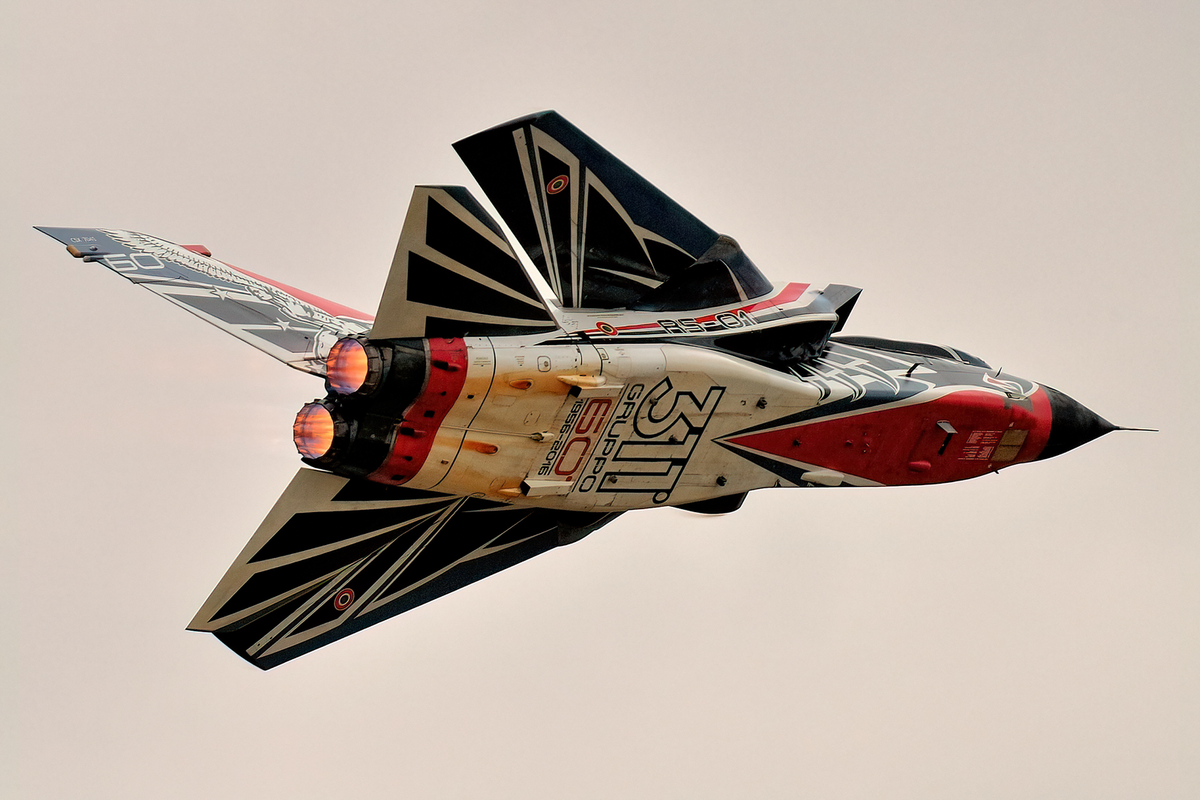
Italian Air Force Tornado Solo Display
Tornado Solo Display
The Italian Air Force Tornado Solo Display was a prestigious aerial showcase featuring the A-200 Tornado aircraft and a skilled pilot from the 311° Gruppo Volo, a unit within the esteemed Reparto Sperimentale Volo (Experimental Flight Unit). Each solo display was meticulously coordinated by a dedicated crew comprising the display pilot, a safety observer, a camera team, a commentator, and engineers, ensuring both exhilarating performances and stringent safety standards. These displays highlighted the exceptional capabilities and versatility of the Tornado in various flight maneuvers and combat scenarios. The tradition of the Tornado Solo Display concluded in 2017, marking the last full solo performance before the Reparto Sperimentale Volo ceased showcasing the Tornado aircraft.
About the Tornado
The Panavia Tornado is a family of twin-engine, variable-sweep wing multi-role combat aircraft developed through a collaborative effort between Italy, the United Kingdom, and Germany. Initiated in the late 1960s, the project emerged from the need to replace a variety of existing aircraft within the partner nations’ air forces, leading to the formation of Panavia Aircraft GmbH in 1969. This multinational consortium, comprising British Aerospace, MBB of West Germany, and Aeritalia of Italy, aimed to create a versatile aircraft capable of fulfilling multiple mission profiles, including interdictor/strike (IDS), electronic combat/reconnaissance (ECR), and air defence interceptor (ADV) roles. The Tornado made its maiden flight on August 14, 1974, and entered service between 1979 and 1980, quickly establishing itself as a cornerstone of the participating air forces due to its adaptability and advanced avionics.
Throughout its operational history, the Tornado participated in numerous conflicts, demonstrating its effectiveness in a variety of combat scenarios. Notably, it played a significant role in the Gulf War of 1991, where it conducted extensive low-altitude penetrating strike missions. Beyond the Gulf, Tornados were deployed in the Bosnian War, Kosovo War, Iraq War, and the 2011 Libyan civil war, among other engagements in Afghanistan, Yemen, and Syria. The aircraft’s ability to perform both conventional and nuclear strike missions, coupled with its advanced navigation and flight systems, allowed it to replace several different types of aircraft within the air forces of its operators. With a total production run of approximately 990 units, the Tornado became one of the most successful postwar bomber programs, with the Royal Saudi Air Force being the only major export customer aside from the original partner nations.
To ensure the Tornado remained a viable frontline aircraft, extensive upgrade and modification programs were undertaken throughout its service life. These enhancements included improvements to avionics, weapon systems, and electronic warfare capabilities, allowing the aircraft to integrate modern precision-guided munitions and advanced sensors. Variants such as the Tornado GR4 and the Tornado ECR received significant upgrades to extend their operational lifespan and enhance their performance in contemporary combat environments. Production concluded in 1998, but the Tornado continued to serve effectively, with projections indicating its service could extend until 2025. The aircraft’s longevity and adaptability underscore its critical role in the air forces of the United Kingdom, Italy, Germany, and Saudi Arabia, highlighting the successful collaboration and engineering prowess behind its development.
Specifications
Crew
2
Length
16.72 m (54 ft 10 in)
Wingspan
13.91 m (45 ft 8 in)
Height
5.95 m (19 ft 6 in)
Max Speed
2,400 km/h (1,500 mph, 1,300 kn)
Combat range
3,148 km (1,956 mi, 1,700 nmi)
Service Ceiling
15,240 m (50,000 ft)
Rate of climb
77 m/s (15,100 ft/min)
A-200 Tornado
The Aeronautica Militare of Italy operates the A-200 variant of the Panavia Tornado, a twin-engine, variable-sweep wing multi-role combat aircraft developed collaboratively by Italy, the United Kingdom, and Germany. The first Italian prototype conducted its maiden flight on December 5, 1975, and the Italian Air Force officially received its initial batch of 100 Tornado IDS aircraft, designated as A-200, on September 25, 1981. These aircraft were integral in replacing multiple older platforms within the Italian fleet, leveraging the Tornado’s versatility to perform a wide range of missions including tactical strike, reconnaissance, and electronic combat. Additionally, 16 A-200s were later converted into the EA-200 configuration to enhance Italy’s Suppression of Enemy Air Defenses (SEAD) capabilities, further solidifying the Tornado’s role within Italy’s air operations.
Throughout its service life, the Italian A-200 Tornado has been actively deployed in various international conflicts, demonstrating its effectiveness and reliability. During the Gulf War in 1991, Italian Tornado A-200s participated in Operation Locusta, deploying eight IDS interdictors to Al Dhafra in Abu Dhabi as part of the coalition forces. Despite the loss of one aircraft to Iraqi anti-aircraft fire, the pilots safely ejected and were subsequently captured. In 1999, a total of 22 Italian Tornados were deployed in NATO’s Operation Allied Force over Kosovo, where the A-200s conducted bombing missions while the EA-200s focused on suppressing enemy air defenses by firing 115 AGM-88 HARM missiles. The A-200 variant also played a significant role in the 2011 military intervention in Libya, enforcing a UN no-fly zone and delivering a substantial number of guided bombs and missiles to support coalition objectives.
To ensure the continued operational readiness and effectiveness of the A-200 Tornados, the Italian Air Force has undertaken extensive upgrade and life extension programs. In July 2002, Italy entered into a contract with the Tornado Management Agency and Panavia to upgrade 18 A-200s, enhancing their navigation systems with integrated GPS and laser inertial navigation systems, and enabling the carriage of advanced weaponry such as Storm Shadow cruise missiles, Joint Direct Attack Munition (JDAM) bombs, and Paveway III laser-guided munitions. Further upgrades initiated in 2010 included the installation of new digital displays, Link 16 communications capabilities, and compatibility with night-vision goggles, among other enhancements. These continuous improvements have allowed the Tornado to remain a vital component of Italy’s air capabilities. However, with the advancement of newer aircraft technologies, Italy plans to eventually replace the Tornado A-200/ECR fleet with the Lockheed Martin F-35 Lightning II, with the final Tornado aircraft scheduled to be retired by 2025, marking the end of a significant chapter in Italy’s military aviation history.
Did You Know?
- The Tornado was the first production aircraft to feature a digital fly-by-wire control system, marking a significant advancement in aviation technology.
- Its variable-sweep wing design allows the Tornado to adjust its wing configuration in flight, optimizing performance for different speeds and mission requirements.
- The Tornado is equipped with a unique terrain-following radar system, enabling it to fly at very low altitudes even in poor weather conditions, which is crucial for strike missions.
- During the Gulf War, the Tornado was involved in the first combat use of the JP233 airfield denial weapon, designed to crater runways and deploy anti-personnel mines.
- The Tornado has served in various roles, including reconnaissance, with the GR1A variant specifically equipped with specialized sensors for this purpose.
Test Your Knowledge
1. What is the maximum speed of the Tornado at sea level?
Inactive Status
Reparto Sperimentale Volo ceased showcasing the Tornado aircraft after 2017








